
Wildlife is big attraction for park visitors
FLORIDA CITY, Fla. — “That’s an alligator!” Jason Park, age 10, shouted pointing at the rippled surface of the water at the Anhinga Trail in the Everglades National Park.
“And that bird over there is an anhinga,” his father, Neal Park, answered indicating a large black bird perched on a nearby tree.
The scenery surrounding father and son is epic. A sea of sawgrass reaches for the horizon, lining pools of fresh water and rocky, tree-topped islands. Through the swampy wilderness winds a wooden boardwalk, the only thing separating the Everglades’ human visitors from its scaled and feathered inhabitants.
| Click on the video at right to view an audio slide show about Everglades alligators prepared and narrated by writer Susan Peavy. |
The Everglades, located in South Florida just south and west of Miami, is the largest sub-tropical stretch of wilderness in the United States. The expanse of marshes, mangroves, sawgrass prairies and tropical fauna was aptly described by environmentalist Marjory Stoneman Douglas as a “river of grass.”
“Alligators, crocodiles, turtles, water birds, fish and manatees” thrive in the unique habitat of the Everglades, according to Park Ranger Leon Howell.
But the immensity of the “river of grass” can be overwhelming, especially for first time visitors. Here are a few tips to make sure you have close wildlife encounters at the Everglades.
Visit the Anhinga Trail.
“At Anhinga, you get closer to the animals than anywhere in the park,” said Everglades patron Kit Caples. She, along with other guests and park employees, unanimously named the Anhinga Trail at Royal Palm number one for wildlife viewing.
| Alligators bask in the sun in a swampy cove at the Anhinga Trail in the south of Everglades National Park (Photos by Susan Peavy). | 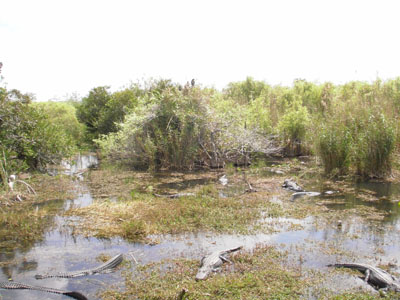 |
“The Anhinga Trail is the best place in the park,” said Larry May, a visitor from Indiana. “If you come here you’ve seen just about everything. Today I’ve seen alligators, anhingas, wood storks and turtles.”
Within a few minutes of strolling along the boardwalk path you will understand why this eight-tenths of a mile trail is a wildlife hot spot.
Swarms of fish are visible just below the murky surface of the slough water, sometimes leaping through the air and landing with a splash. Large wading birds populate the shores and the trees and alligators grin at every turn.
Caple’s visit led her to one dead-ending lookout surrounded by a clan of 14 alligators basking in the sun. The view was met with cries of “wow, look at them all,” and “oh boy.”
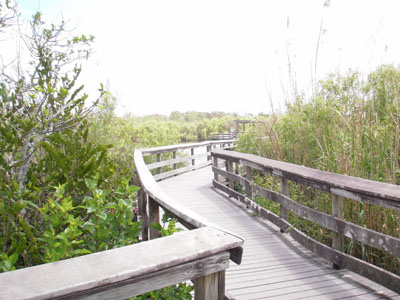 |
The Anhinga Trail boardwalk winds through the sawgrass prairie and watery slough of the “river of grass.” |
“Seeing 14 alligators close up is pretty amazing,” said Caple’s friend and first-time visitor Tom Casadevall, beaming like a little boy at Christmas.
It’s difficult not to be impacted by the proximity of wildlife on this trail.
Come during the winter
“Winter season, from mid-December to the end of February, is the wildlife season,” Ranger Howell explained.
“The whole thing is based on the water cycle. In the summer, when it rains almost every day, the water level is up.” This spreads wildlife throughout the park, as there are plenty of areas of deep water throughout.
“In the winter, when it’s dry, all the animals that need water go to where the water remains, and Anhinga is one of those places. The water cycle concentrates the food.”
Where the prey goes, the predators follow, making Anhinga in wintertime a prime place to spot alligators. Winter is also the season for birds, as they migrate from the north to sunny Florida.
| An anhinga dries its wings along the Anhinga Trail. Below, in winter, water levels remain high at Anhinga Trail. Next, tree tops emerge from the water, speckled with wading birds who feed on abundant fish. Below, a baby alligator struggles in grass along the trail. Last, park signs warn drivers to watch for endangered Florida panthers. | 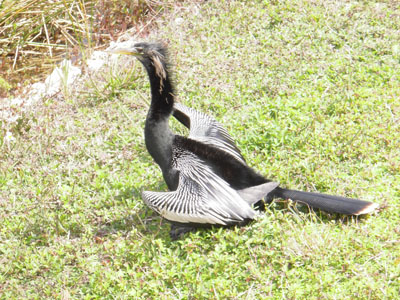 |
“We get a lot of birds in the winter that aren’t here in the summer,” Howell explained.
Winter is also the most popular season to visit the park, as the wildlife is concentrated and the weather is more comfortable. In 2009, the highest numbers of guests visited in January, February and March, with total recreational visits of 104,251, 107,537 and 115,054 respectively. The months with the lowest numbers of recreational visits were June, August and September, with 48,696, 51,957 and 44,519 respectively (according to the National Park Service Public Use Statistics Office).
Participate in a ranger-led program
Walking the Everglades’ many trails 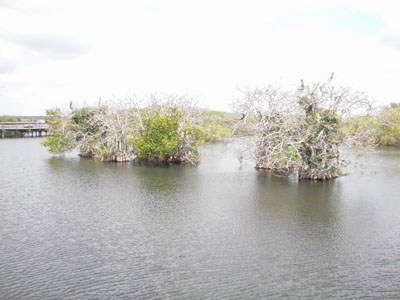 with a guide is a good way to learn about the ecosystems and to identify birds and other wildlife.
with a guide is a good way to learn about the ecosystems and to identify birds and other wildlife.
Stop at the Ernest Coe Visitor Center at the south entrance of the park near Florida City to learn about the ranger led programs and special events being held that day.
“Learn as much as possible about the habitat,” Ranger Howell recommended. “The more you know about it, the cooler it is.”
He currently conducts a ranger led tour through Anhinga every morning at 10:30 a.m., where he details the slough habitat and the way it works.
The slough is “a slow moving channel of water flowing through the sawgrass prairie,” an informational sign explains.
Spot crocs and manatees at Florida Bay
While the Anhinga Trail is generally teeming with wildlife, there are a few animals you will not encounter there, such as the American crocodile.
“It’s not impossible,” said Howell. “But they have a much better habitat in the mangroves.” This is because crocodiles like a mixture of salt and fresh water, while alligators live in fresh water.
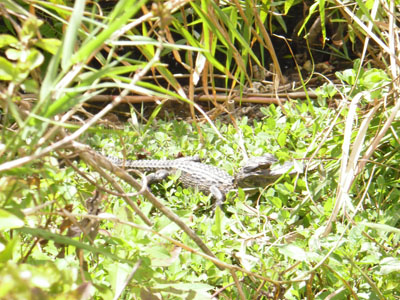 “The Everglades is the only place in the world where alligators and crocodiles cohabitate,” said Headquarters Receptionist Dale Singer of the unique ecosystem at the park.
“The Everglades is the only place in the world where alligators and crocodiles cohabitate,” said Headquarters Receptionist Dale Singer of the unique ecosystem at the park.
But if you want to spot them both, you’ll have to seek them out separately.
“You have a 50/50 chance to see crocodiles at Flamingo overlooking Florida Bay,” Howell said. “That’s the most consistent place to see them because they come out to bask in the sun.”
As with the other animals, though, winter is the time to spot them. “They don’t bask in the sun in the summer because it’s too hot.”
At Florida Bay, you can also spot manatees “and always birds,” said Howell.
Keep your eyes peeled
While many animals parade in the open, some wait to be discovered in unexpected places. Search between the blades of grass or under the leaves that coat the slough and you may be pleasantly surprised.
A group of guests at Anhinga discovered a baby alligator no more than a foot long hiding behind the trees lining the boardwalk. Be on the lookout for rare animals as well in water land and sky.
“The rarest animal in the park without question is the Florida panther,” Howell explained. “If you were in the park and saw it you’d probably want to buy a lottery ticket that day. It’s really lucky.”
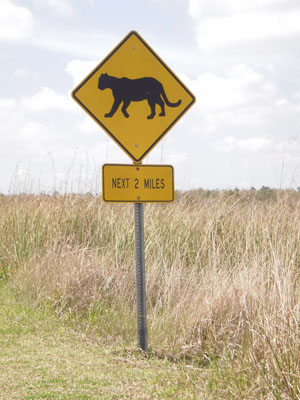 If You Go:
If You Go:
- Wear sunscreen and comfortable shoes.
- Bring water and a field guide to birds to identify the many types that live in the Everglades.
- All visitor centers (Ernest Coe, Flamingo, Shark Valley and Gulf Coast) are open 365 days a year.
- Stop at the Ernest Coe Visitor Center to find out the programs being held that day. It is located at 40001 State Road 9336,Homestead, Fla. 33034. Directions (from U.S. 1 South): Turn right onto Palm Drive (State Road 9336 / SW 344th Street) and follow signs to the park. Hours of operation: 9 a.m. to 5 p.m. Phone: 305-242-7700 (ask for visitor center).
- The Flamingo Visitor Center is located roughly 38 miles south of the park entrance.
Directions (from U.S. 1 south): Turn right onto Palm Drive (State Road 9336 / SW 344th Street) and follow signs to the park. Continue driving south about one hour. Hours of operation: 9 a.m. to 4:30 p.m. Phone: 239-695-2945. - The Royal Palm, where the Anhinga Trail is located, lies several miles south of the Ernest Coe Visitor Center. Follow signs for Royal Palm after entering the park.
- The Anhinga Trail is wheelchair accessible.

Comments are Closed